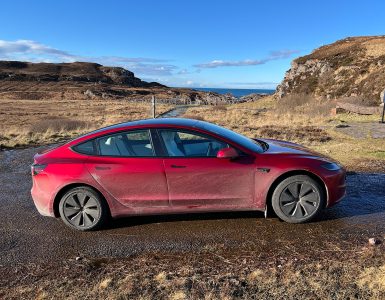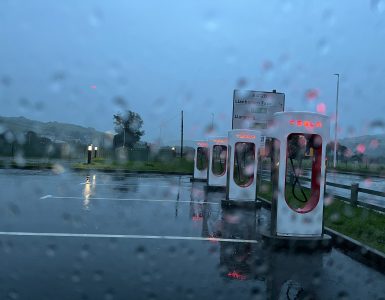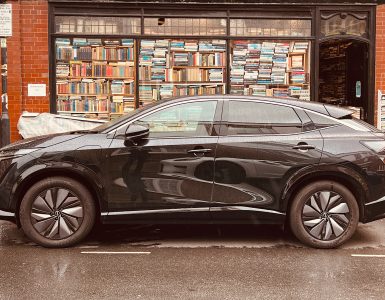As an electric car owner it’s funny sometimes what you hear said about EV’s (Electric Vehicles), mostly by people who have only tried one for an hour or sometimes not tried a recent EV at all. All they seem sure of is “if Greta says you should abandon piston cars they must be worse right?”
So you might be surprised to hear that in polls of people who actually drive electric cars less than 1 in 10 would even consider a piston car when they come to replace their EV. Polls have been conducted with similar results around the world but in the November 2020 poll conducted by Zapmap 2000 UK electric and plugin hybrid drivers were asked whether they would consider switching back to petrol or a diesel. 91% said they wouldn’t even consider a combustion car. 8% would consider it and 1% said they would want to switch back.
So how is driving EV’s (electric vehicles) different.. and.. better than petrol or diesel or mild hybrid or plugin hybrid cars?
Starting the car
Well there’s no engine so with most EV’s you just get in, turn on, select “drive” or “reverse” and off you go. Simples!
“Running in” your new EV
When you get into a new EV you might wonder what the running in procedure is. After all with combustion engine cars you’re normally advised to keep revs down for the first few hundred miles. EV’s need “no running in”. The moment you get in you can use any of its performance wherever it is safe to do so
Clearing ice and heating the car
Owners of piston cars have to walk out in the cold, turn on the engine in the vain hope it will warm up in time to help and then scrape the ice off the windscreen. On frosty mornings most electric cars come with phone apps that let you heat the car while you finish your toast. So by the time you get to the car, not only has the ice has melted off the windows but the cabin is warm and the seats can be warmed up too. Of course if you’re so posh you have a butler they could warm your piston car before you get in but EVs are a lot less hassle and never need a day off
Throttle response
EV’s deliver their torque and acceleration instantly. While most piston cars take a second or a few seconds to move after you press the accelerator EVs just go.. It comes as standard whether it’s an electric Fiat 500 or a Tesla. So if you’re on a roundabout, see a safe gap and the car doesn’t move you’re in a piston car. Cold day? No bother..an EV doesn’t need to spend time warming the engine before it works properly!
Power delivery
Combustion engines deliver very different amounts of power and torque depending on engine’s speed or the RPM (revolutions per min). Piston car drivers have got used to the fact these engines produce so little power and torque that they stall below around 1,000 rpm and may need to be revved hard to provide power is needed.
With electric motors the power and torque are available all the time which is why no piston cars at any price can beat the quickest performance electric car in a drag race to 60mph or even 100mph. Even cars like a new BMW M3 will only catch up with a (less expensive) Tesla Model 3 Performance EV when it reaches over 120mph.
Going up a hill
EVs will happily do hill starts and go up and down hills with no problem, no fuss. They don’t need you to manage a clutch or rev an engine for a hill start. They have electric handbrakes to hold you still then when you accelerate they go. They don’t need to be in a particular gear to accelerate or go up a hill because they just have an electric motor not an engine and gearbox.
Going down a hill
Even going down hill is easier in an EV because using regenerative braking you can control your speed with just the accelerator pedal. As long as you pick an EV had decent levels of “regen” you could even come down a 25% gradient without needing to involve your old “friction brakes. With piston cars your brakes are used so much they can fade or overheat on long descents.
Smoothness & refinement
For decades piston carmakers have tried to build engines and manual or automatic gearboxes that change gear faster and more smoothly without jerky gear changes.
Well not surprisingly electric motors that work at any speed from 1mph to 180mph without a gearbox or the need for any gears your drive is super smooth and more refined than any car still needing a gearbox.
Reliability
A petrol or diesel car has around 2,000 moving parts. An electric car has about 20. Having fewer mechanical parts doesn’t guarantee they will be more reliable than cars with engines, gearboxes, exhausts, particulate filters etc it certainly helps. The Telsa Model 3, its most affordable Model came top in the compact executive WhatCar? 2020 reliability survey well ahead of cars like the BMW 3 series, Audi A4 and the least reliable executive car, the Mercedes C Class.
Noise outside the car
Electric cars are quiet. Because they don’t have a clattering diesel or a petrol engine absolutely no one will be impressed by the enormous sound you make revving behind a cyclist. There is no revving and no noisy exhaust releasing poison gases either.
Some people worry EV’s are “too quiet” especially at low speeds under 15mph. In fact new EV’s now have to make a little artificial noise to make them louder especially when there are still noiser piston vehicles around them. Wind forward to the near future when most vehicles are electric, a diesel clatter or petrol engine will probably seem so loud that people will turn and wonder what noisy old vehicle is coming down their road.
Noise inside the car
It’s equally serene inside an EV with no motor sound at all in most models. In fact because they are so quiet carmakers have to spend a lot of time to reduce all the other noise that’s normally hidden by the engine, like wind and tyres.
Interior space
Piston cars have to waste lots of space for a big engine up front and a “transmission tunnel” that creates a raised hump through the centre of the car that connects the engine to the other mechanical bits & fuel tank at the back of the car. Although some EV’s converted from fuel burning models still have this hump (between the legs of a rear middle seat passenger), EVs designed from the ground up have a completely flat floor with the batteries underneath it. So even a rear centre passenger has somewhere to put their feet! Because EV’s don’t need a long bonnet the passenger cabin usually has much more space than a combustion car the same size.
Ironically most fake “electrified” or plugin hybrid EV’s like a Mercedes E-class have even less room than a petrol or diesel.. ending up with a boot the size of a Golf!
Filling up compared to charging
Drivers of combustion cars probably think EV owners must have extraordinary patience sitting around for hours waiting to charge their batteries. Of course the answer is we don’t, we go and do anything we want to do.
Think about the process of filling up with petrol or diesel. Have you ever while filling up managed to sleep in your own bed, or eaten a meal, or visited a city centre or done your weekly supermarket shop. With an EV you can all of these things. You can even go to the toilet while charging an EV! You just connect to the charger and leave it.
By contrast to fill up a petrol or diesel car you have drive to a petrol station and then stand there while you fill it with carcinogenic liquid and fumes. You can’t even look at your phone (because it could ignite you and your car and the petrol station!).
Charging time compared to filling up time
It still takes hours right? Nope that’s a myth too. There are 2 types of charging used by almost every electric car, slow AC charging and fast DC charging.
AC slow charging is super slow but mostly cheaper (or even free), usually 7kW which adds around 20 miles of range per hour. You use this when your car is at home or for tops ups when your car would parked somewhere anyway like at the Supermarket or overnight at a hotel. If you don’t have a driveway there are more an more public street chargers including many that plug into existing lamp posts.
If you’re charging where the car would be parked anyway then you save time compared to driving to a garage, filling up, paying for fuel and then driving back in a petrol or diesel car. EV owners with an AC charger at or near home wake up every day to a full battery. In fact if they just charged up to 200 miles range every morning they could do up to 73,000 miles a year without ever visiting a public charger!
What about when you need to charge quickly? You simply use super fast DC charging. DC chargers can give between 50kW and 350kW depending what the charger can deliver and the car can take. Chargers are getting faster every year so if your car charges at 100kW or more you’ll find more and more places to charge quickly. What is key is to pick an EV with a charging speed (in kW) at least double the battery size (in kWh) then most charges will take between 15 and 35 mins. But if you do decide on a lunch stop your EV keeps filling up.
Long Journeys
Many EV’s can now handle DC charges from 10% up to 60% or 70% in 20 to 35 minutes. In an EV like a Tesla Model 3 you only need to stop for 15 to 20 minutes every 3 hours or 150 miles. After 3 hours driving it’s nice to have a stretch, stand up or check your phone.
On a 6 hour flight you may not get the opportunity step outside for some fresh air and a stretch but when driving it seems a shame not to make the most of not being 35,000 feet up in the air as you then arrive fresher and more relaxed at your destination. In theory you could make it from London to North Yorkshire or the Lake district on a 100% charge without stops but it’s much more relaxing to sip some extra power regularly and have a toilet and coffee break even if it adds around 10% to your trip time.
Servicing intervals and and routine maintenance
Some buyers probably ask their car dealership whether they should buy the piston or the electric car. And the dealer will probably say that electric cars are a disaster. And of course the dealer is right, if you are a car dealership that makes most of its profits servicing piston cars then electric cars are a complete disaster because they need almost no servicing.
Apart from tyres, brake fluid and replacing cabin air filters there’s remarkably little to do. There’s no oil to check or top up or replace, no exhaust, no particulate filters etc. Even brake pads last many times longer on EVs because you use motors for most braking. While Tesla has no fixed servicing dates at all on a Model 3. most other brands are trying to insist on a service every 2 years to keep dealers happy and let them check for faults and update software. An EV should still be much cheaper with fewer nasty surprises. Replacing your wiper blades and topping up your brake fluid is the new normal for EV servicing.
Batteries
EV batteries are guaranteed for 8 years on most cars, not just against failure (something that’s very rare) but also against losing more than 30% of their charge compared to when new. The price of batteries is also falling every year and the batteries are getting are getting better. For example early Nissan Leaf’s can now have recycled batteries from newer Leaf’s that have had an accident giving them far better range than when the car was new.
EV’s currently use the same mined materials used in your phone battery and computers, including cobalt. Massive investment is going into cleaning up this process and recycling all the valuable materials into new batteries at the end of life. In addition EV makers are increasingly switching to 100% renewable energy to build the cars and the batteries so that carbon emissions are minimised in construction as well as while driving. Some EV’s have batteries that are expected to and regularly do last 500,000 miles- far further than a typical combustion engine.
Unlike your phone almost all EV’s (except the Nissan Leaf) have cooling or heating to keep your EV batteries in perfect condition and help to protect the battery during repeated high speed charging.
Safety
Electric cars are remarkably safe and Tesla EV’s have consistently been given the highest safety ratings for
- Crash avoidance – systems that use brakes or steering to avoid accidents
- Crash protection – the battery packs under the floor strengthen the protection in the passenger cabin in the event of an accident
- Occupant protection – extra features like air bags to reduce the risk of injury in an accident
There has been a lot of publicity about fires. It is true this risk isn’t something limited to “combustion” vehicles but the Latest information from Tesla suggests their EVs have 1 fire for every 205 million miles driven compared to 1 fire every 19m miles for combustion cars. In fact combustion engine cars catch fire so often every day that it’s never worth reporting in the news. It is true that when an EV does have a serious fire it takes much longer to put out and firemen will need to be trained & equipped to put them out.
Air pollution
Air pollution from vehicles is a curse on everyone around them including in other vehicles. It kills tens of thousands of people every year in the UK alone.
There are broadly 2 types of pollution – gases and particulate. Both damage cells all over the human body and trigger a range of conditions including asthma, heart disease and lung cancer.
Most air pollution comes from engine exhausts which is zero on an EV along with particulate from brakes which is hard to measure but much lower from electric cars because most use regenerative braking that produces zero particulate. As a result the brakes pads on an EV are used less and last about 2 to 4 times as long as on a piston vehicle that always uses its brake pads to stop.
Finally tyres also produce particulate and distribute particles already on the road into the air. While EV’s are a little heavier and may increase this effect they are a similar weight to many comparable sized combustion cars especially SUV models and lower speed limits and traffic congestion reduce this pollution source from all vehicles in urban areas.
Overall, air pollution from combustion engines is highest in slow or stationary city traffic where it affects the most people and whereas pollution from EV’s is at its lowest in slow city traffic.
Fuel versus charging cost
A typical petrol or diesel combustion car with fuel at £1.30 a litre will cost £169 to do 1,000 miles while a car doing 45mpg would cost £131. By comparison the best selling EV based on 285Wh/mile or 3.5 miles per kWh would cost
- £196 on an Ionity charger(69p/kWh)
- £114 on an Instavolt charger (40p/kWh)
- £85.50 on a Gridserve charger (30p/kWh)
- £68.40 on a Ubitricity lamp post (24p/kWh)
- £14.25 charging at home off peak (5p/kWh)
As you can see there is quite a variation but relatively few people would make an Ionity (or Source London) a regular charging option so in general EV’s cost a little or a lot less than a combustion vehicle to power.
Piston, hybrid, hydrogen or electric to prevent climate change
To avoid the worst effects of climate change we need to cut our CO2 emissions by around 45% by 2030. A car you buy today will help decide whether we manage to achieve that or not. The latest 2021 ICCT study found that hybrid cars result in 20% less CO2 per mile used over the life of the vehicle compared to a petrol or diesel car. A plugin hybrid regularly charged up can cut CO2 by 42% while EV’s cut emissions by 65-69% and by 80% when the power to charge the car is 100% renewable or nuclear.
Power in the UK is already much cleaner than it was with only about 40% coming fossil fuels – mainly gas and about 2% coal.
Neither hybrids, nor plugin hybrid cut emissions enough to help avoid catastrophic climate change over 1.5c.
Hydrogen doesn’t really help either as nearly all of it is produced from Methane that increases global warming. Making hydrogen from renewable energy is very very inefficient and expensive. Until that changes hydrogen for cars and vans won’t catch on.
Essentially if you buy another car that isn’t electric the only way you can meet climate change targets is to halve how much fuel you buy and by driving your car half the distance. It is quite likely governments will encourage fossil fuel drivers to do just that.
Reducing CO2 from driving every year
When you buy a petrol, diesel or hybrid car it won’t produce less CO2 in 5 years time. If anything CO2 will go up as the combustion engine gets older and any small hybrid battery gives you less range before needing the engine.
By contrast an EV benefits from lower carbon electricity. Charge at night and it could lower your CO2 even more because most overnight power is from wind power in the UK. Drive in 5 years time when even less electricity will come from burning gas and coal and the CO2 will get even lower. For example between 2015 and 2020 the number of days when more UK electricity came from renewables than fossil fuels went from 2 to 8 to 33 to 75 to 116 to 203 days in 2020.
Going round a corner
EV’s are for the moment a little heavier than a combustion engine but the weight mainly in the batteries which are under the vehicle. This gives even taller EV models a much lower centre of gravity than an equivalent piston car and that means they all corner pretty well- comfortable and flat. Despite 100 years of development, combustion cars no one has managed to flatten a piston cars mechanicals and put them under the car. Which is why piston supercars have to make everything else so low that you practically have to sit on the tarmac and scrape on the bumper on speed humps.
The other difference is the moment you lift your foot off the accelerator an EV slows down using regen. EV owners find this much more intuitive and easy than using the brake pedal. It just flows better as a way of driving down a twisty road and means you’re much more likely to be doing a safe speed when you can’t see pedestrians, cyclists or horses round a corner.
Over the air updates
While some Electric cars can’t do this yet or need to visit a dealer, an EV can get updated just like your phone by connecting to wifi. In the case of my Tesla these have delivered faster acceleration, Netflix and Youtube, a new dashcam and may other upgrades all for free without visiting a dealer. It means often even a “recall” can be done with a software update.
Taxes
If you love paying as much tax as possible definitely keep buying cars that burn fossil fuels. From filling up to VED (currently zero) to benefit in kind you have a fabulous opportunity to pay thousands of pounds more if you choose a diesel saloon over an EV. Of course much of this extra money will be spent treating people for the effects of air pollution or try to protect homes from flooding or fires and excess heat caused by climate change so that is just as well.
Sitting in an EV versus a piston vehicle
EV’s have the remarkable ability to run the radio, your hands free phone or even the aircon without running an engine. Yes thats right, no noise, no toxic air pollution needed in order to eat a sandwich or make a call while parked before school pick up. So kids (and everyone else) can breathe healthy air around you. Amazing isn’t it.
How long will vehicles last?
The big growth in EV sales has been in the last 2 years so most electric vehicles are Nissan Leafs and vans and Teslas. The signs so far are they still have effective batteries and that they have remarkably low maintenance needs and are very reliable even when doing high mileages. When I say high mileage some Tesla Model S EV’s are doing extraordinary distances with one in Germany up to 1.33 million km and expected to exceed 1m miles next year. It has used 3 sets of batteries.
Use of resources over the lifetime of a car after recycling
Building any vehicle uses resources. Big investments are going into recycling EV’s and their batteries at end of life. It will need laws to ensure it happens for all makes and soon the value of what can be recycled along with more efficient techniques will make recycling more economic. It’s not a done deal but it seems likely the used resources in an EV will end up being about the size of a football. By comparison a 35mpg petrol or diesel car over 200,000 miles will have burned about 6,000 gallons of diesel or petrol fuel that can never be used again or recycled and renders our planet uninhabitable.
Self driving Cars
These don’t have to be electric but as soon as they are available each one will replace around 6 private cars. Why? Because private cars (fuel burning or electric) sit around for 95% of the time doing nothing.. except depreciating of course. EV’s get lower in CO2 and in cost the more miles they are driven. That means a driverless EV used more often will cut our CO2 even more than a private EV today.
Calling a “driverless taxi” will also be much much cheaper than driving your own car and can be sized to your needs for each journey. Big and luxurious to take the family on holiday and small and simple for a short trip to work. Essentially it will do to private cars what Spotify did to CD sales and in the process eliminate bills for servicing insurance and tax because they will be included in your ride cost.
Clean air zones and congestion charge
There is no such thing as a clean petrol or diesel exhaust any more than there is a healthy cigarette. EV’s are exempt from clean air zone charges and for the moment congestion charges as well. If you drove into central London every day using an EV would save you £5,460 per year in congestion charges alone.. (No one currently has to pay on Christmas day). EV’s don’t pay because they don’t produce exhaust gases and particulate that harms every part of the human body and costs the NHS millions of pounds every month for trips to GP’s and A & E.
Managing electricity demand
Many of our national newspapers regularly publish FUD articles designed to instil fears about alleged disasters looming if we switch to EV’s or even air source heat pumps. Usually using data and quotes from oil, gas and hydrogen lobbyists this Fear, Uncertainty and Doubt is designed to stop you moving away from fossil fuels.
One chestnut is that the grid will collapse and you won’t be able to make a pot of tea if we switch to electric cars. The people who know about this issue, UK’s National Grid are not only not worried about this but think EV’s will help the grid. Why? Because by using software, EV chargers can delay charging at peak times. They can even push electricity back into the grid when needed and then charge up again later when there is spare capacity. This all helps balance demand for electricity especially at times when wind turbines are still generating overnight providing a perfect time for EV’s to charge.
Anything bad?
There really isn’t much. Personally I found my EV is the best car I’ve ever owned. Downsides including driving more because it’s so much more enjoyable. EV’s are fine on winter snow but some have tyres that aren’t so check or plan for winter tyres if you do a lot of winter journeys. Other than that you just have to make sure you can stick to coffee or water on those motorway stops. If the lure of a burger king is strong you may have to go running more often!
Still not sure?
Just ask EV owners what it’s like. They are mostly a very friendly bunch and will help you with any question however silly. Just please don’t ask them if it still has an engine as a back up as well or if it’s “self charging! For the record cars that are misleadingly advertised as “self charging” or “electrified” are simply petrol or diesel piston cars with a tiny battery & motor to make them a little more efficient. They are not electric.
Fully charged show asked some leading EV owners and you can see their top tips here







[…] So your new electric car has arrived, you’ve got a pretty good idea how to drive the car but not much more than that. So lets kick off. Firstly you’ve made a great choice. Click here to see why almost no electric cars owners want to go back to piston cars here. […]